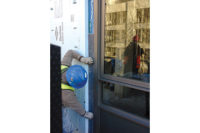Modern construction is being driven by building performance requirements, that is, we are now constructing with high regard to sustainability. More specifically, I believe that the building envelope is being considered more as a living component. Beyond the aesthetic appeal, it needs to perform as a living element. It must regulate temperature, prohibit moisture intrusion, breathe, act as a barrier from the elements, and of course must look marvelous.
Continuous insulation plays an important role as a performance addition to the life and function of the exterior envelope. It insulates across all framing members which, is the most effective way to insulate. One of the most cost effective exterior insulation is EIFS but there are many other assemblies and configurations that incorporate foam products that contribute to the exterior insulation requirements. Which begs the question: when is a cladding EIFS and when is it something else?
To be EIFS
EIFS was the first on the block to be designed as an insulating cladding system. Look at the components that make up an EIF system; expanded polystyrene (EPS), acrylic modified cement and fiberglass mesh layer (lamina), and an acrylic finish. This is simplicity performing complex tasks.
Now look at our current modern construction where the building envelope “lives” and is expected to perform a host of other functions, dictated by the code requirements of increased energy efficiency. EIFS meets these requirements and then some. To supercharge the EIF systems, EIFS gurus have developed and made available an additional air and moisture barrier coating, a drainage plane component, pressure equalization and enhanced product chemistry.
The beauty of it all is that it doesn’t really add a lot of pieces and parts, or cost, but greatly increases the performance capabilities. However, back in the late-’90s, EIFS unjustly got a big ol’ target on their backs, the mark of the “M”, causing designers and owners to not want the EIFS.
They didn’t mind using EPS, but giving in to the myths and rumors, “No EIFS” was their distinct cry. I give credit to the EIFS industry for their ongoing performance testing and development of new systems, and their extensive education to continually dispel the myths.
CI and Stucco
I remember applying stucco over foam many years ago in the early 80’s. We did it without any worries, WRB, foam, wire and trims, stucco and finish. This was the Southwest where rain was the exception and sunshine, blue skies, and heat, the daily norm. With the recent code requirements to building performance, stucco over foam became a hot button item; no one was really familiar with the assembly.
We at the TSIB came out with The Energy Code and Plaster Assembliesguide, to provide a birds-eye view of CI and the plastering industry. It illustrates the use of CI in stucco assemblies and illustrates three of the most commonly installed stucco assemblies. One is stucco over CI, this is the assembly I had done for many years and in fact is currently used every day in the housing industry with one-coat stucco products. Another is the installation of foam in between Z channels. The metal Z channels are attached to a given substrate and hold the foam in place.
One may then install sheathing to the outer face of the Z’s or metal lath can be directly fastened. This is not really true to the definition of CI in that the Z’s can act as thermal bridges, unless constructed with thermal breaks. And finally, as illustrated in the brochure, is foam over stucco. Here is where the definition of EIFS can be questioned.
The brochure states that the addition of foam, a lamina and an acrylic finish, may not be EIFS (this was intended for the EIFS naysayers to be able to construct this assembly). Because the assembly meets the criteria of a stucco cladding, the addition of an insulating layer is just that, an insulating layer. We do recommend that a single manufacturer EIF system be applied, but recognize that a true EIF system is not required. Let’s explore...
Not to Be EIFS
Let’s first look back to the unwarranted “target” placed on the EIFS industry (whisper the word mold here...) It was supposed that the foam trapped moisture and caused a host of maladies. Due to the hype at the time, some forbade and still, some currently forbid EIFS—no exceptions. Some will however, allow a stucco cladding, or other cladding product, over foam. I am no scientist but water doesn’t know what an assembly is and it will travel as it knows how.
If you don’t tell water where to go, it will go where it pleases, usually into your wall assembly. So, if one allows stucco, or wood, or cement board to be applied over foam, why not EIFS? Assumption: EIFS is a bad word, ergo, foam with a lamina and an acrylic finish applied over stucco, supplied by an EIFS manufacturer, is acceptable. Crazy, right? Let’s go even further.
If a contractor applies a stucco cladding and has a foam shape, or many shapes, with acrylic modified cement base coat and an acrylic finish applied on top, do we call it EIFS? Is one-coat stucco over foam EIFS? So in the brochure we say, foam basecoat and mesh and an acrylic finish, applied over a stucco assembly, is not EIFS, which I continue to support. OK, let me pull us out of the mud.
Conclusion
EIFS is a system that combines an insulating component and a weather resistive lamina, (protection of the foam and framed assembly) finished by a decorative acrylic product. It can be enhanced by coatings that protect the sheathing from moisture or air infiltration (suspenders), or with finishes that repel dirt, grime or other environmental contaminates. The EIF system is a shopping cart of specialized components and various aesthetic finishes, which functions alone as a high performance exterior insulating cladding.
Stucco is an assembly of a water-resistive layer, various metal or vinyl components, some cement, lime and sand, which are then assembled into a weather resistive exterior cladding. It is a mass of given thickness backed by a WRB that does the work to keep out the moisture. It is a time proven well recognized cladding but, it is not an insulating component for a wall assembly unless it is applied over foam. Modern construction uses a lot of embellishments to these assemblies like pop-outs, quoins, window surrounds, cornice details, dentils etc., all “planted–on” with foam, basecoat and mesh components, and in a lot of instances, an acrylic finish.
It can be confusing to distinguish between the two claddings. Because EIFS is so easy to work with, years ago the stucco industry began to utilize some of the components only, not the system, to enhance and beautify stucco claddings. Laminas, foam shapes, acrylic primers and finishes began their sojourn into the stucco assemblies. Foam aesthetic features moved less than their wood framed counterparts, and laminas applied to the stucco surface all contributed to less cracking.
Continuous insulation is the “new” requirement and I believe that EIFS is the natural fit, the true definition and first choice for CI. I also believe that stucco over foam is an alternate choice for a CI cladding and ranks top-of-the-list, for exterior insulated cladding assemblies, second only to EIFS.







Report Abusive Comment